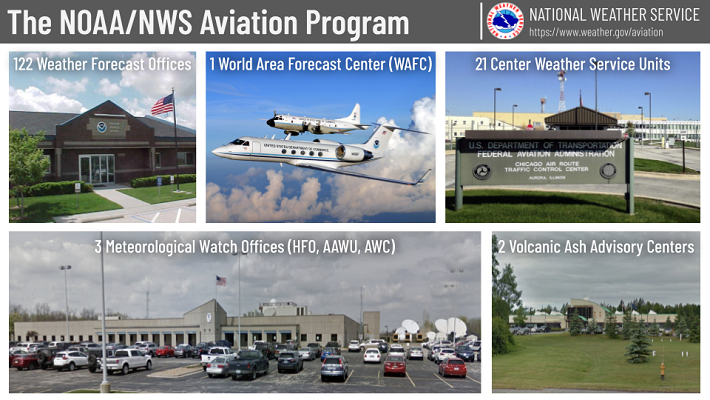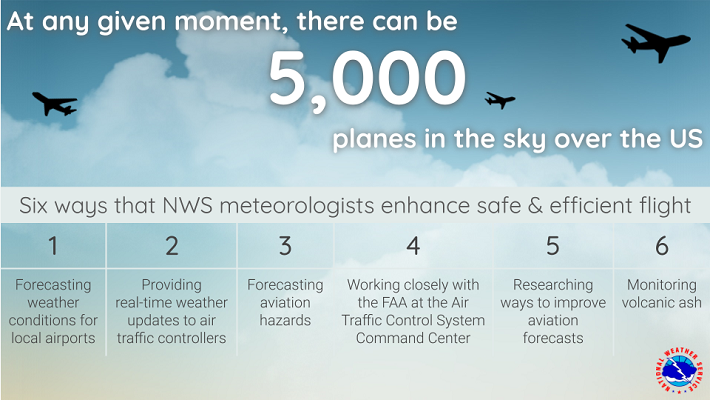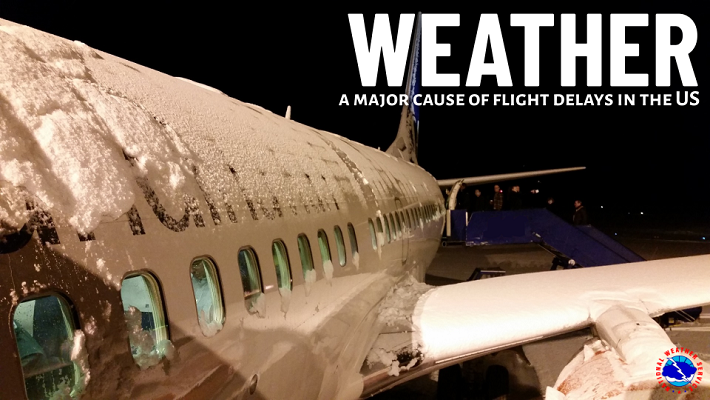Aviation
National Program




Weather is an important part of aviation. At any given time, there can be over 5,000 planes in the sky across the U.S. to carry passengers and cargo to their destinations. Aside from a flight delay due to storms, other hazards that can affect a flight include aircraft icing, turbulence, and volcanic ash. Weather information helps pilots and airlines plan flights to efficiently use airspace and resources by utilizing favorable conditions and avoiding potentially hazardous weather.
Click on the buttons below to learn more about the ways that the National Weather Service supports the aviation community.
NWS Involvement in Aviation
Directly forecasting aviation weather and hazards. Meteorologists who perform these tasks work at the three meteorological watch offices which cover US airspace: the Aviation Weather Center (AWC), the Alaska Aviation Weather Unit (AAWU), and the Honolulu Forecast Office (HFO).
Providing real-time weather updates and forecasts to air traffic controllers. These meteorologists work at the 21 Center Weather Service Units (CWSU) which are co-located with FAA Air Route Traffic Control Centers (ARTCC).
Working closely with the FAA. National Aviation Meteorologists (NAMs) work hand-in-hand with the FAA at the Air Traffic Control System Command Center (ATCSCC).
Monitoring volcanic ash. This is done at one of two NWS Volcanic Ash Advisory Centers (VAACs). One is in Anchorage, AK and the other is in Washington, D.C. There are only 9 VAACs around the world.
Forecasting local airport weather conditions. Meteorologists working at 122 Weather Forecast Offices (WFO) around the country issue forecasts for over 700 airports and actively interact with their local aviation communities.
Supporting flight planning. Flight planners rely on forecasts of winds and temperatures aloft. NWS staff at the Environmental Modeling Center (EMC) and the NCEP Central Operations (NCO) maintain the computer models that produce these forecasts.
Supporting hurricane research and forecasting. The NOAA’s Office of Marine and Aviation Operations (OMAO) maintains two P-3 Orion aircraft and one G-IV jet for hurricane research and real-time reconnaissance flights.
Researching ways to improve aviation forecasts. All levels of the NWS conduct specialized research and work to translate the latest research findings into operations (R2O).
Providing IT support.Dedicated staff oversee a large network and help maintain a seamless flow of information.
Hazards in Aviation
Commercial flights, emergency medical flights, cargo transport, and general aviation are all sensitive to weather hazards. Aviation meteorologists issue a suite of products to alert pilots to potentially dangerous conditions associated with the following hazards:
Turbulence: Turbulence is the name for air movements that cause rapid unplanned aircraft motions. Turbulence can develop anywhere from near the surface to very high up in the atmosphere. SIGMETs are designed to help pilots and dispatchers identify airspace with potentially impactful turbulence. This helps them keep aircraft within flight limits for the safety and comfort of passengers.
Low-Level Wind Shear (LLWS): Wind shear is a rapid change in wind speed, wind direction, or both. Low-level wind shear means that the rapid changes in wind speed and/or direction are happening near the ground. LLWS can significantly affect take-offs and landings. When LLWS conditions are expected to develop, NWS forecasters will include it in the Terminal Aerodome Forecast (TAF) for the affected airports.
Sustained surface winds > 30 knots: Take-offs and landings are very sensitive to the wind speed and direction at the runway. That's why it's important to know about strong surface winds, especially if the wind is blowing perpendicular to any given runway. In some cases, certain runways can't be used because the winds are too strong. This can limit how many aircraft are allowed to land and depart from the airport.
Icing: Liquid water can exist even when the air temperature is below freezing. When an aircraft flies through these environmental conditions, ice can build up on the aircraft's surfaces. Too much ice build-up will decrease aircraft performance and affect its ability to fly. SIGMETs are designed to alert pilots of potentially dangerous icing conditions.
Freezing Levels: The freezing level is the height at which the air temperature crosses 32°F (0°C). Freezing levels can be used to assess the overall icing risk as well as to help identify areas where icing may develop.
IFR Conditions: "IFR" stands for "Instrument Flight Rules". "IFR" means that a pilot must rely heavily on their instruments because the weather is preventing them from seeing very far ahead. Pilots need special training and instrumentation to fly in IFR conditions. The specific thresholds for IFR conditions are as follows: cloud ceiling heights below 1000 feet and/or runway visibility of less than 3 miles. These key thresholds affect aviation operations such as aircraft spacing for take-offs and landings. Graphical AIRMETs highlight areas where IFR conditions are expected.
Mountain Obscurations: Rain, clouds, and fog can limit a pilot's ability to see mountainous terrain. It is important for pilots to be aware of potential mountain obscurations so that they don't develop a false sense of visual safety. Just beacause they can't see it doesn't mean it's not there!
Thunderstorms: Thunderstorms can greatly disrupt the atmosphere around them through the production of lightning, rain, hail, and gusty or erratic winds. A large part of the NWS's aviation program involves helping pilots avoid flying in or near thunderstorms, both in real-time and in-flight planning.
Volcanic Ash: Volcanic eruptions can spew ash clouds of different thicknesses to different heights. Once the ash debris has been lofted into the air, the wind can move it far away from the volcano. Volcanic ash poses significant risk because it damages aircraft engines. NWS Volcanic Ash Advisory Centers (VAAC) in Washington and Anchorage monitor volcanic eruptions, watch for ash clouds, and issue products as needed to warn pilots and flight dispatchers about the presence of volcanic ash.
Aviation Partners
National Weather Service aviation forecasters coordinate daily with a wide variety of partners depending on their aviation responsibilities. Some of the partner organizations include:
Aviation Supporting Offices
The National Weather Service has numerous offices that help support the aviation community at a national, regional, and local level. Click the links below to learn more about each entity:
All of the NWS employees who support aviation operations are dedicated to providing high-quality weather information and services to enhance safe and efficient flight across the national airspace system 24 hours a day.
To learn more about how the National Weather Service supports the aviation community, select a button below or choose an option from the drop down menu across the top of the page.

